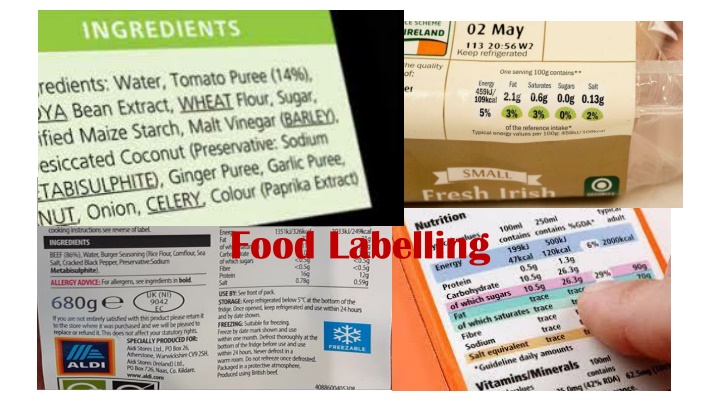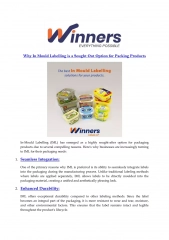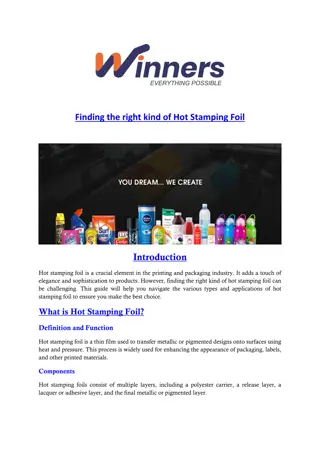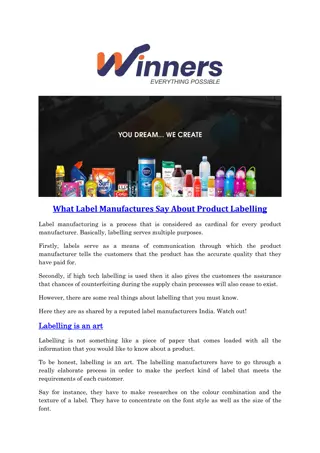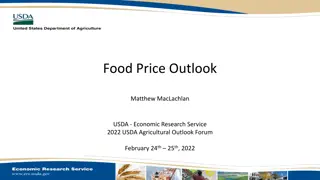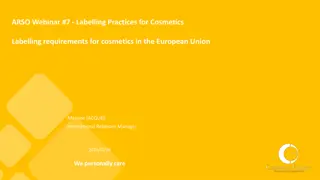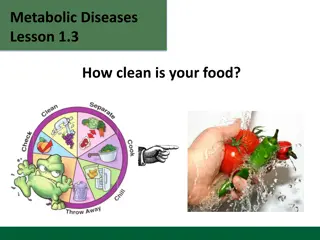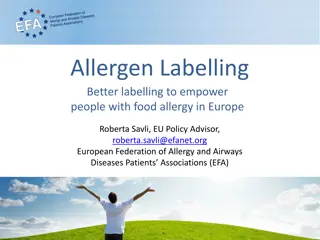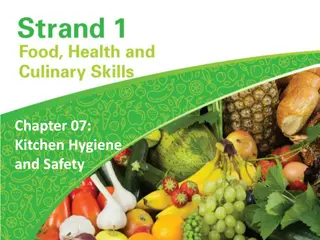Food Labelling
Food labelling is crucial in providing essential information to consumers, ensuring transparency and safety. Under EU regulations, strict rules govern both packaged and non-packaged food labelling, necessitating clarity, accuracy, and education for consumers. Labels must include product names, allergens, usage instructions, net quantity, ingredient lists, storage recommendations, best before dates, nutritional information, and manufacturer details. By adhering to these guidelines, consumers can make informed choices based on facts and use products safely.
Download Presentation

Please find below an Image/Link to download the presentation.
The content on the website is provided AS IS for your information and personal use only. It may not be sold, licensed, or shared on other websites without obtaining consent from the author.If you encounter any issues during the download, it is possible that the publisher has removed the file from their server.
You are allowed to download the files provided on this website for personal or commercial use, subject to the condition that they are used lawfully. All files are the property of their respective owners.
The content on the website is provided AS IS for your information and personal use only. It may not be sold, licensed, or shared on other websites without obtaining consent from the author.
E N D
Presentation Transcript
We will learn about : Requirements the rules of labelling for packaged and non-packaged foods? Labelling the information that must be shown on packaging. Non-packaged food what has to be shown.
Food Labelling Under EU regulations all food labelling must follow strict rules. Certain information must be given about packaged and unpackaged food. The Food Safety Authority is responsible for the enforcement of correct food labelling under EU Food Information for the Consumer - FIC Regulation 2011
Food Labelling Labelling must be: Unambiguous and clear. It cannot mislead the consumer Labelling in Ireland must be in English (Irish or other languages can be shown along with English) The text should be legible (easy to read) and indelible (impossible to be rubbed out or erased).
Food Labelling Information on food labels should: Educate you about products you buy (choices that are based on facts) e.g. ingredients/nutritional information Help you make informed choices e.g. the quantity of beef in a pack of beefburgers Help you to use products safely e.g. use by date/allergens/storage.
Food Package Labels Must Have Product name Allergens Instructions for use Net quantity List of ingredients in descending order
Food Package Labels Must Have Storage instructions Best before/use by date Nutrition information Name and address of manufacturer
Food Package Labels Must Have Certain nutrition information must be in a table per 100g/ml: The energy value The amounts of fat, saturates, carbohydrates, sugars, protein and salt.
Food Package Labels Must Have The quantity of certain ingredients that helps the consumer to understand the product better e.g. beef in beefburgers. This makes it possible to compare similar products.
Food Package Labelling Certain other vitamins and minerals can also be displayed if present in specific levels. If the salt content is exclusively due to naturally occurring sodium than that can be stated.
Food Package Labels Must Have The Country of Origin must be shown for beef, fish, pork, goat poultry, fresh fruit and veg. honey and olive oil and where the country of origin of a final food is given and where this is not the same as the origin of the primary ingredient or if its absence is misleading.
Food Package Labels Must Have The alcoholic strength must be shown on drinks that contain more than 1.2% alcohol.
Food Package Labelling Certain other nutrients can be displayed: Monounsaturates Polyunsaturates Polyols Starch Fibre
Food Package Labelling It is possible to add the nutritional values per portion and to give the % Reference Intake (RI).
Food Package Labelling Certain nutrients may be repeated on the front of pack if a food business chooses to provide this additional information: Energy/energy along with fat, saturates, sugar and salt Per 100g/ml or per portion When providing this Front of Pack information energy must always be indicated per 100g/ml as a minimum
Non-Package Food Labelling For non-packaged food certain information must be displayed with the food: Allergens Name, country of origin, variety of food Price per kg to be able to compare
Food Claims There are very strict rules when it comes to Nutrition and Health Claims. They have to be 100% true and approved by the EU.
References Slide 1 - https://encrypted-tbn0.gstatic.com/images?q=tbn:ANd9GcQhwpIxGIGb44TnxCNZ5FWJHaDGY5LbN_OFKw&usqp=CAU https://www.irishtimes.com/polopoly_fs/1.2638191!/image/image.jpg_gen/derivatives/landscape_490/image.jpg Diabetes.ie Https:/aldi.ie Slide 3 & 4 - Https:/aldi.ie Slide 5 & 6- https://www.fitzgeraldsbakery.ie Slide 9 - https://world.openfoodfacts.org/product/5000116018130/birds-eye-orginalbeef-burgers Slide 11 - https://shop.supervalu.ie/shopping/food-cupboard-boyne-valley-honey-33-extra-fill-454-g-/p-1008549000 World.openfoodfacts.org Slide 12 - Rachelpaulsfood.com Slide 13 & 14 - https://bloodsugartrampoline.com/blog/index.php/2017/05/24/how-to-read-the-nutritional-label-the-basics Slide 15 - https://www.irishtimes.com/polopoly_fs/1.2638191!/image/image.jpg_gen/derivatives/landscape_490/image.jpg Slide 16 http://www.fsai.ie https://encrypted-tbn0.gstatic.com/images?q=tbn:ANd9GcTRfMKo46E2HHEejvBZTgg2KDN2uNaHN7n8zw&usqp=CAU
